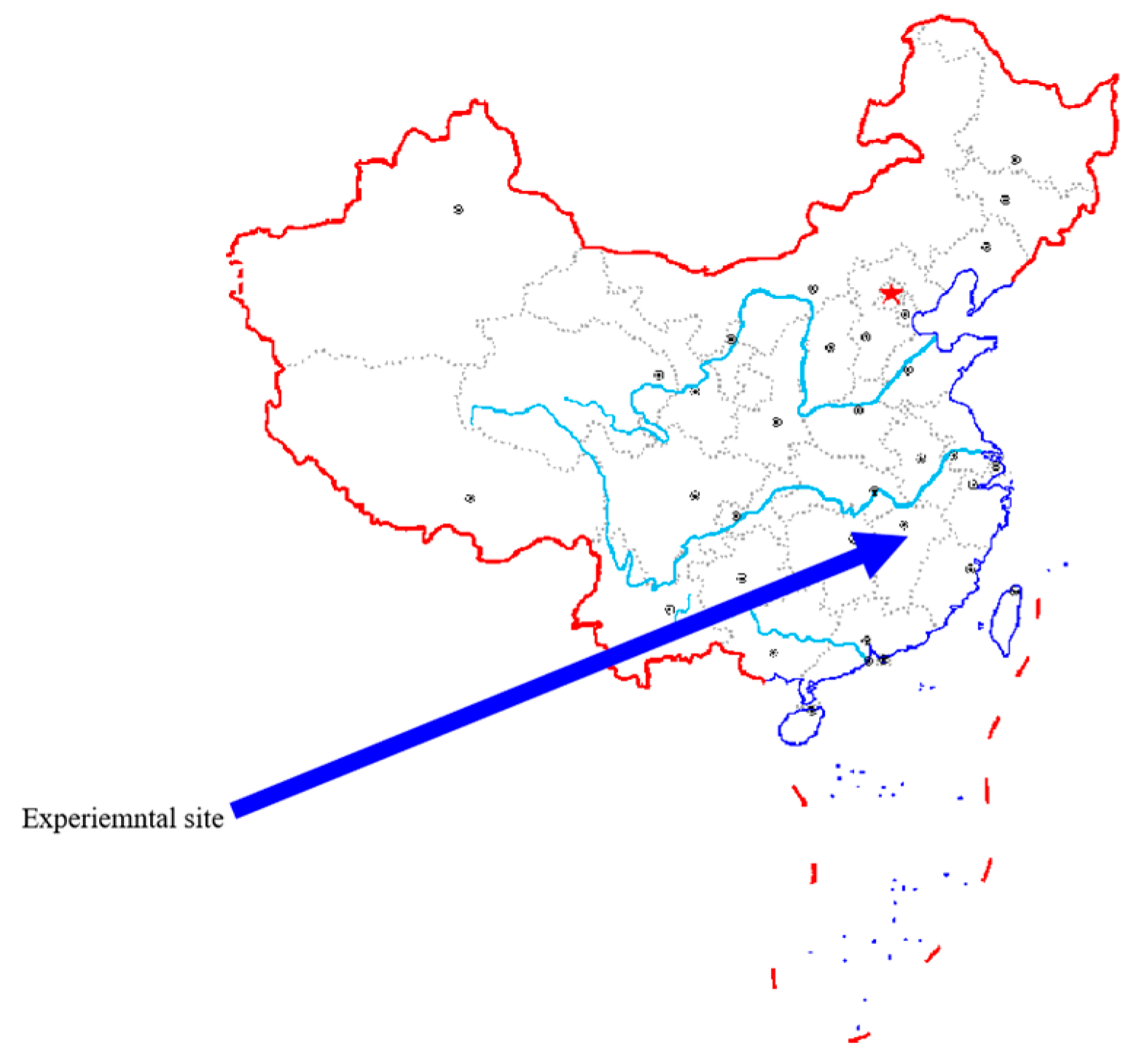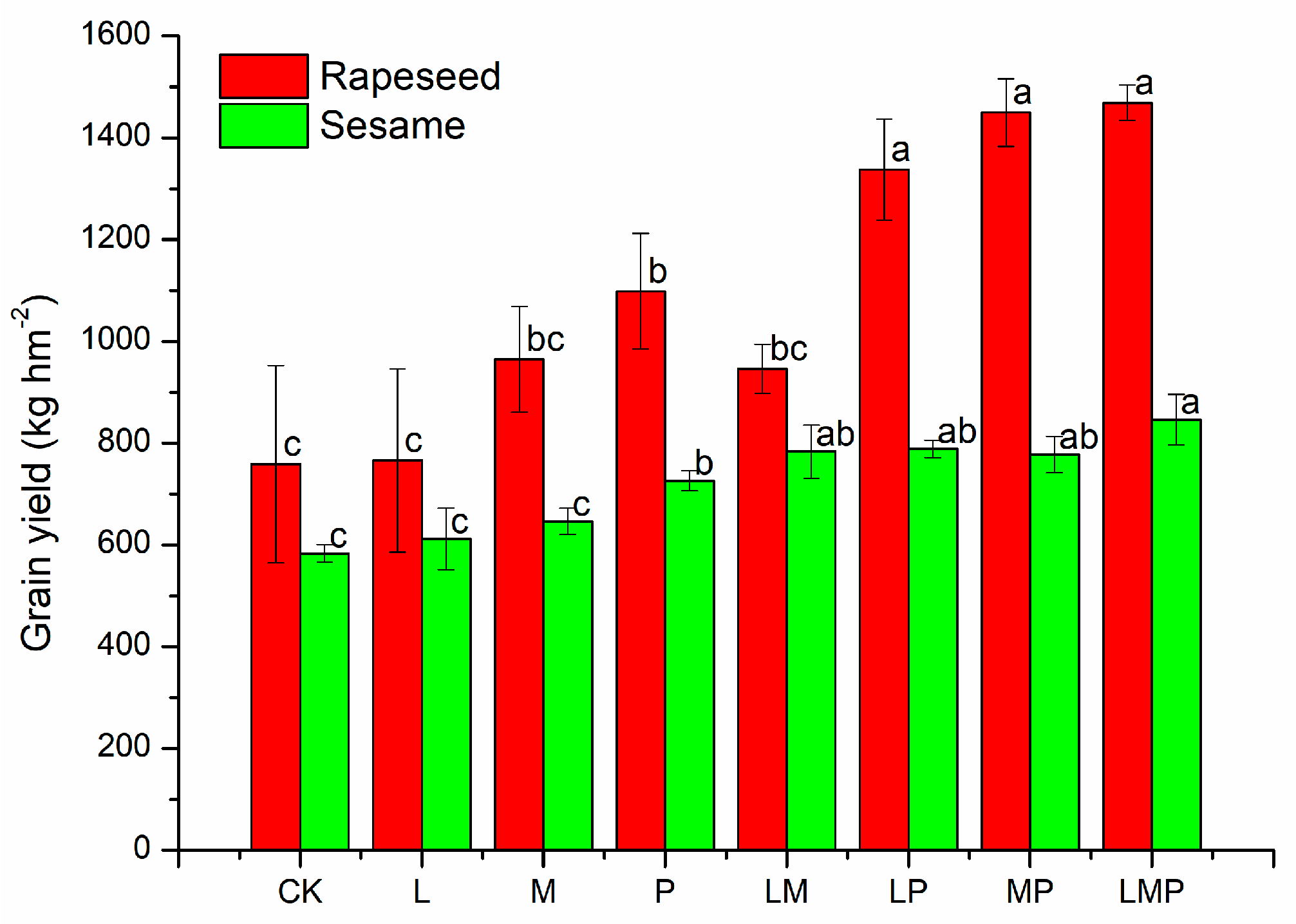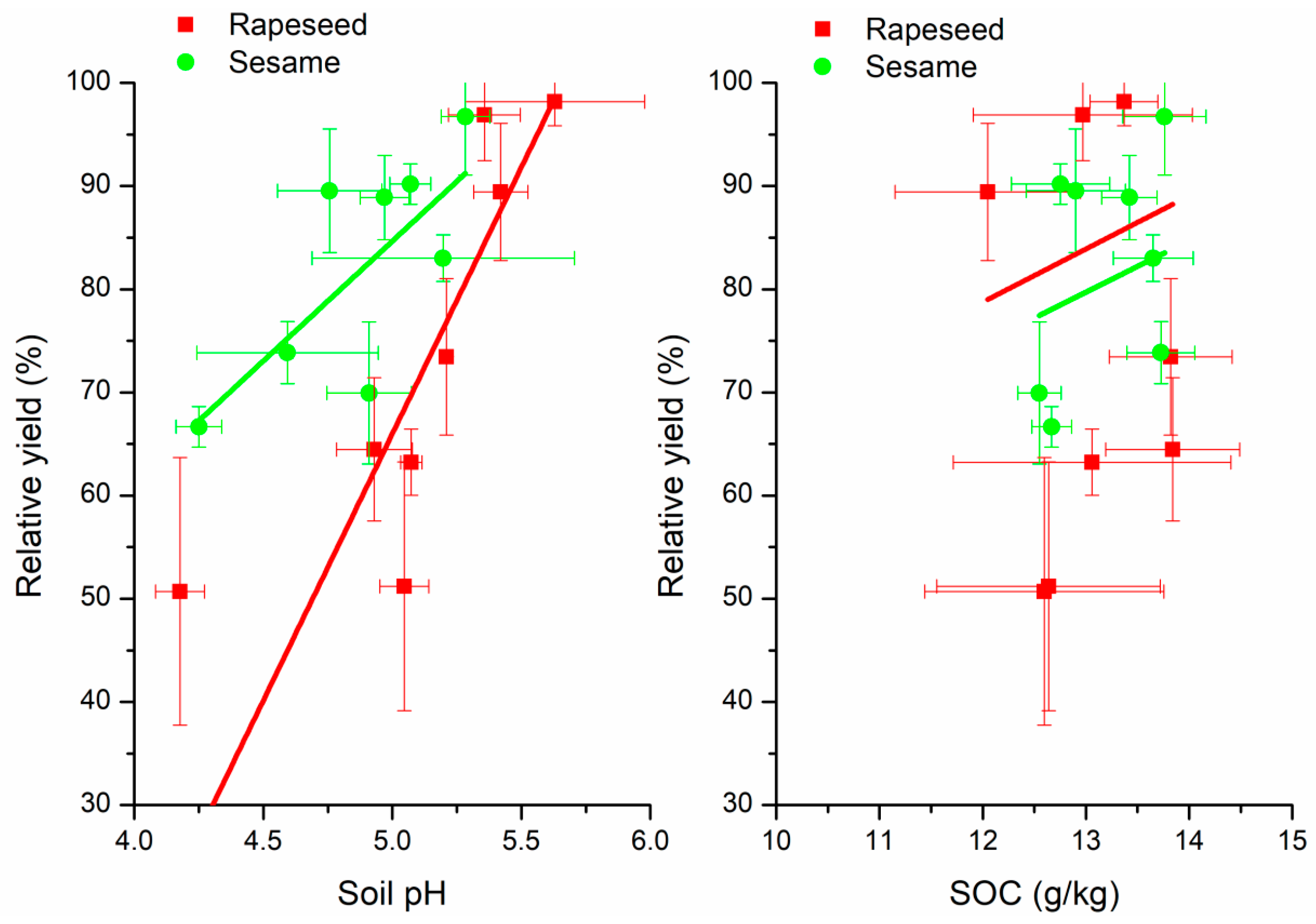The Combined Application of Inorganic and Organic Materials over Two Years Improves Soil pH, Slightly Increases Soil Organic Carbon, and Enhances Crop Yields in Severely Acidic Red Soil
Abstract
1. Introduction
2. Materials and Methods
2.1. Experimental Site Description
2.2. Experimental Design
2.3. Sample Collection and Measurement
2.4. Data Analysis
3. Results
3.1. Effects of Inorganic and Organic Material Application on Crop Yield in Red Soil
3.2. Effects of Inorganic and Organic Material Application on Soil pH in Red Soil
3.3. Effects of Inorganic and Organic Material Application on SOC in Red Soil
3.4. Correlation Between Soil pH, SOC, and Yield After Inorganic and Organic Material Application in Red Soil
4. Discussion
4.1. The Role of Inorganic and Organic Material Combinations in Enhancing Crop Yields via Soil Acid Reduction and Fertility Improvement in Red Soil
4.2. Soil Acidification and Crop Yield Relationships Under Combined Inorganic and Organic Application
5. Conclusions
Author Contributions
Funding
Data Availability Statement
Conflicts of Interest
References
- Zhao, X.; He, C.; Liu, W.; Liu, W.; Liu, Q.; Bai, W.; Li, L.; Lal, R.; Zhang, H. Responses of Soil pH to No-till and the Factors Affecting It: A Global Meta-analysis. Glob. Chang. Biol. 2022, 28, 154–166. [Google Scholar] [CrossRef]
- Dalton, R.M.; Miller, J.N.; Greaver, T.; Sabo, R.D.; Austin, K.G.; Phelan, J.N.; Thomas, R.Q.; Clark, C.M. Regional Variation in Growth and Survival Responses to Atmospheric Nitrogen and Sulfur Deposition for 140 Tree Species Across the United States. Front. For. Glob. Chang. 2024, 7, 1426644. [Google Scholar] [CrossRef]
- Guo, J.H.; Liu, X.J.; Zhang, Y.; Shen, J.L.; Han, W.X.; Zhang, W.F.; Christie, P.; Goulding, K.W.T.; Vitousek, P.M.; Zhang, F.S. Significant Acidification in Major Chinese Croplands. Science 2010, 327, 1008–1010. [Google Scholar] [CrossRef]
- Raza, S.; Miao, N.; Wang, P.; Ju, X.; Chen, Z.; Zhou, J.; Kuzyakov, Y. Dramatic Loss of Inorganic Carbon by Nitrogen-induced Soil Acidification in Chinese Croplands. Glob. Chang. Biol. 2020, 26, 3738–3751. [Google Scholar] [CrossRef] [PubMed]
- Barcelos, J.P.; Sánchez-Rodríguez, A.R.; Bargiela, R.; Mariano, E.; Gloyshina, O.V.; Jones, D.L.; Rosolem, C.A. Lime, Gypsum, and Nitrogen as Drivers to Increase the Abundance of Soil Fungi and N-cycling Microorganisms in Integrated Agricultural Systems. Appl. Soil Ecol. 2024, 202, 105549. [Google Scholar] [CrossRef]
- Holland, J.E.; White, P.J.; Glendining, M.J.; Goulding, K.W.T.; McGrath, S.P. Yield Responses of Arable Crops to Liming–An Evaluation of Relationships Between Yields and Soil pH From a Long-term Liming Experiment. Eur. J. Agron. 2019, 105, 176–188. [Google Scholar] [CrossRef] [PubMed]
- Puissant, J.; Jones, B.; Goodall, T.; Mang, D.; Blaud, A.; Gweon, H.S.; Ashish Malik, A.; Jones, D.L.; Clark, I.M.; Hirsch, P.R.; et al. The pH Optimum of Soil Exoenzymes Adapt to Long term Changes in Soil pH. Soil Boil. Biochem. 2019, 138, 107601. [Google Scholar] [CrossRef]
- Bossolani, J.W.; Crusciol, C.A.C.; Mariano, E.; Fonseca, M.; Moretti, L.G.; Momesso, L.; Portugal, J.; Costa, N.R.; Calonego, J.C.; Kuramae, E.E. Long Term Co-application of Lime and Phosphogypsum Increases 15 N Recovery and Reduces 15 N Losses by Modulating Soil Nutrient Availability, Crop Growth and N Cycle Genes. Eur. J. Agron. 2023, 149, 126907. [Google Scholar] [CrossRef]
- Sądej, W.; Żołnowski, A.C.; Marczuk, O. Content of Phenolic Compounds in Soils Originating From Two Long-term Fertilization Experiments. Arch. Environ. Prot. 2016, 42, 104–113. [Google Scholar] [CrossRef]
- Mockeviciene, I.; Repsiene, R.; Amaleviciute-Volunge, K.; Karcauskiene, D.; Slepetiene, A.; Lepane, V. Effect of Long-term Application of Organic Fertilizers on Improving Organic Matter Quality in Acid Soil. Arch. Agron. Soil Sci. 2022, 68, 1192–1204. [Google Scholar] [CrossRef]
- Guo, Z.; Zhang, J.; Fan, J.; Yang, X.; Yi, Y.; Han, X.; Wang, D.; Zhu, P.; Peng, X. Does Animal Manure Application Improve Soil Aggregation? Insights From Nine Long-term Fertilization Experiments. Sci. Total Environ. 2019, 660, 1029–1037. [Google Scholar] [CrossRef] [PubMed]
- Lotse Tedontsah, V.P.; Mbog, M.B.; Bitom-Mamdem, L.; Ngon Ngon, G.F.; Edzoa, R.C.; Tassongwa, B.; Bitom, D.; Etame, J. Spatial Distribution and Evolution of pH as a Function of Cation Exchange Capacity, Sum of Exchangeable Bases, and Organic Matter and Aluminum in the Soils of Foumban. Appl. Environ. Soil Sci. 2023, 1, 5172804. [Google Scholar] [CrossRef]
- Mustafa, A.; Xu, H.; Shah, S.A.A.; Abrar, M.M.; Maitlo, A.A.; Kubar, K.A.; Saeed, Q.; Kamran, M.; Naveed, M.; Wang, B.; et al. Long-term Fertilization Alters Chemical Composition and Stability of Aggregate-associated Organic Carbon in a Chinese Red Soil: Evidence from aggregate fractionation, C mineralization, and 13 C NMR analyses. J. Soils Sediments 2021, 21, 2483–2496. [Google Scholar] [CrossRef]
- Mi, W.; Sun, Y.; Xia, S.; Zhao, H.; Mi, W.; Brookes, P.C.; Liu, Y.; Wu, L. Effect of Inorganic Fertilizers with Organic Amendments on Soil Chemical Properties and Rice Yield in a Low-productivity Paddy Soil. Geoderma 2018, 320, 23–29. [Google Scholar] [CrossRef]
- Yu, Z.; Chen, H.Y.; Searle, E.B.; Sardans, J.; Ciais, P.; Peñuelas, J.; Huang, Z. Whole Soil Acidification and Base Cation Reduction Across Subtropical China. Geoderma 2020, 361, 114107. [Google Scholar] [CrossRef]
- Iticha, B.; Mosley, L.M.; Marschner, P. Combining Lime and Organic Amendments Based on Titratable Alkalinity for Efficient Amelioration of Acidic Soils. Soil 2024, 10, 33–47. [Google Scholar] [CrossRef]
- Lu, R.K. Soil and Agro-Chemical Analytical Methods; China Agricultural Science and Technology Press: Beijing, China, 1999; pp. 146–195. [Google Scholar]
- Cahyono, P.; Loekito, S.; Wiharso, D.; Afand; Rahmat, A.; Nishimura, N.; Noda, K.; Masateru, S. Influence of Liming on Soil Chemical Properties and Plant Growth of Pineapple (Ananas comusus L. Merr.) on Red Acid Soil, Lampung, Indonesia. Commun. Soil Sci. Plant Anal. 2019, 50, 2797–2803. [Google Scholar] [CrossRef]
- Holland, J.E.; White, R.; Haefele, S.M.; Goulding, K.W.T.; McGrath, S.P.; Glendining, M.J. Long-term Effects of Lime and Phosphorus Application on Soil Extractable (Olsen) Phosphorus Differ Between Two Arable UK Soils. Soil Use Manage. 2024, 40, e13160. [Google Scholar] [CrossRef]
- Chalmers, A.G. A Review of Fertilizer, Lime and Organic Manure Use on Farm Crops in Great Britain From 1983 to 1987. Soil Use Manage. 2001, 17, 254–262. [Google Scholar] [CrossRef]
- Whalen, J.K.; Chang, C.; Clayton, G.W. Cattle Manure and Lime Amendments to Improve Crop Production of Acidic Soils in Northern Alberta. Can. J. Soil Sci. 2002, 82, 227–238. [Google Scholar] [CrossRef]
- Wang, J.; Yang, X.; Huang, S.; Wu, L.; Cai, Z.; Xu, M. Long-term Combined Application of Organic and Inorganic Fertilizers Increases Crop Yield Sustainability by Improving Soil Fertility in Maize-wheat Croping Systems. J. Integr. Agric. 2025, 24, 290–305. [Google Scholar] [CrossRef]
- Haynes, R.J.; Naidu, R. Influence of Lime, Fertilizer and Manure Applications on Soil Organic Matter Content and Soil Physical Conditions: A Review. Nutr. Cycl. Agroecosyst. 1998, 51, 123–137. [Google Scholar] [CrossRef]
- Islam, M.R.; Talukder, M.M.H.; Hoque, M.A.; Uddin, S.; Hoque, T.S.; Rea, R.S.; Alorabi, M.; Gaber, A.; Kasim, S. Lime and Manure Amendment Improve Soil Fertility, Productivity and Nutrient Uptake of Rice-mustard-rice Cropping Pattern in an Acidic Terrace Soil. Agriculture 2021, 11, 1070. [Google Scholar] [CrossRef]
- Li, J.; Cooper, J.M.; Li, Y.; Yang, X.; Zhao, B. Soil Microbial Community Structure and Function Are Significantly Affected by Long-term Organic and Mineral Fertilization Regimes in the North China Plain. Appl. Soil Ecol. 2015, 96, 75–87. [Google Scholar] [CrossRef]
- Das, P.P.; Singh, K.R.; Nagpure, G.; Mansoori, A.; Singh, R.P.; Ghazi, I.A.; Kumar, A.; Singh, J. Plant-soil-microbes: A Tripartite Interaction for Nutrient Acquisition and Better Plant Growth for Sustainable Agricultural Practices. Environ. Res. 2022, 214, 113821. [Google Scholar] [CrossRef] [PubMed]
- Agegnehu, G.; Nelson, P.N.; Bird, M.I. Crop Yield, Plant Nutrient Uptake and Soil Physicochemical Properties under Organic Soil Amendments and Nitrogen Fertilization on Nitisols. Soil Till. Res. 2016, 160, 1–13. [Google Scholar] [CrossRef]
- Ran, W.; Xu, F.; Zhang, Y.; Zhang, W.; Zhang, J.; Sun, M.; Wang, C.; Ding, G. Development of Acid-resistant Seed Pelletization Formula and Its Effects on Improving Rapeseed Growth in Acidic Soil. Plant Soil 2024, 504, 147–165. [Google Scholar] [CrossRef]
- Su, R.; Zhou, R.; Mmadi, M.A.; Li, D.; Qin, L.; Liu, A.; Wang, J.; Gao, Y.; Wei, M.; Shi, L.; et al. Root Diversity in Sesame (Sesamum indicum L.): Insights into the Morphological, Anatomical and Gene Expression Profiles. Planta 2019, 250, 1461–1474. [Google Scholar] [CrossRef] [PubMed]
- Daba, N.A.; Li, D.; Huang, J.; Han, T.; Zhang, L.; Ali, S.; Khan, M.N.; Du, J.; Liu, S.; Legesse, T.G.; et al. Long-term Fertilization and Lime-induced Soil pH Changes Affect Nitrogen Use Efficiency and Grain Yields in Acidic Soil under Wheat-maize Rotation. Agronomy 2021, 11, 2069. [Google Scholar] [CrossRef]
- Zhang, H.; Wang, B.; Xu, M. Effects of Inorganic Fertilizer Inputs on Grain Yields and Soil Properties in a Long-term Wheat-corn Cropping System in South China. Commun. Soil Sci. Plant Anal. 2008, 39, 1583–1599. [Google Scholar] [CrossRef]
- de Vargas, J.P.; dos Santos, D.R.; Bastos, M.C.; Schaefer, G.; Parisi, P.B. Application Forms and Types of Soil Acidity Corrective: Changes in Depth Chemical Attributes in Long Term Period Experiment. Soil Till. Res. 2019, 185, 47–60. [Google Scholar] [CrossRef]
- Ghimire, R.; Machado, S.; Bista, P. Soil pH, Soil Organic Matter, and Crop Yields in Winter Wheat–summer Fallow Systems. Agron. J. 2017, 109, 706–717. [Google Scholar] [CrossRef]
- Chahal, I.; Hooker, D.C.; Deen, B.; Janovicek, K.; Van Eerd, L.L. Long-term Effects of Crop Rotation, Tillage, and Fertilizer Nitrogen on Soil Health Indicators and Crop Productivity in a Temperate Climate. Soil Till. Res. 2021, 213, 105121. [Google Scholar] [CrossRef]
- Aula, L.; Omara, P.; Dhillon, J.S.; Fornah, A.; Raun, W.R. Influence of Applied Cattle Manure on Winter Wheat (Triticum aestivum L.) Grain Yield, Soil pH and Soil Organic Carbon. Commun. Soil Sci. Plant Anal. 2019, 50, 2056–2064. [Google Scholar] [CrossRef]
- Du, L.; Zhang, Z.; Chen, Y.; Wang, Y.; Zhou, C.; Yang, H.; Zhang, W. Heterogeneous Impact of Soil Acidification on Crop Yield Reduction and Its Regulatory Variables: A global meta-analysis. Field Crops Res. 2024, 319, 109643. [Google Scholar] [CrossRef]
- Tong, X.; Xu, M.; Wang, X.; Bhattacharyya, R.; Zhang, W.; Cong, R. Long-term Fertilization Effects on Organic Carbon Fractions in a Red Soil of China. Catena 2014, 113, 251–259. [Google Scholar] [CrossRef]
- Couëdel, A.; Falconnier, G.N.; Adam, M.; Cardinael, R.; Boote, K.; Justes, E.; Smith, W.N.; Whitbread, A.M.; Affholder, F.; Balkovic, J.; et al. Long-term Soil Organic Carbon and Crop Yield Feedbacks Differ Between 16 Soil-crop Models in Sub-Saharan Africa. Eur. J. Agron. 2024, 155, 127109. [Google Scholar] [CrossRef]
- Mustafa, A.; Xu, M.; Shah, S.A.A.; Abrar, M.M.; Sun, N.; Wang, B.R.; Cai, Z.J.; Saeed, Q.; Naveed, M.; Mehmood, K.; et al. Soil Aggregation and Soil Aggregate Sstability Regulate Organic Carbon and Nitrogen Storage in a Red Soil of Southern China. J. Environ. Manage. 2020, 270, 110894. [Google Scholar] [CrossRef]



| Treatments | Lime (kg hm−2) | Fully Fermented Pig Manure (kg hm−2) | Calcium–Magnesium–Phosphate (kg hm−2) |
|---|---|---|---|
| CK | 0 | 0 | 0 |
| L | 1125 | 0 | 0 |
| M | 0 | 1500 | 0 |
| P | 0 | 0 | 750 |
| LM | 1125 | 1500 | 0 |
| LP | 1125 | 0 | 750 |
| MP | 0 | 1500 | 750 |
| LMP | 1125 | 1500 | 750 |
| Treatments | Soil pH | |
|---|---|---|
| Rapeseed | Sesame | |
| CK | 4.18 ± 0.10e | 4.25 ± 0.09d |
| L | 5.05 ± 0.10d | 4.91 ± 0.16abc |
| M | 4.93 ± 0.15d | 4.59 ± 0.35cd |
| P | 5.07 ± 0.04cd | 4.76 ± 0.20bc |
| LM | 5.21 ± 0.03bcd | 5.20 ± 0.51ab |
| LP | 5.42 ± 0.11ab | 5.07 ± 0.08abc |
| MP | 5.36 ± 0.14abc | 4.97 ± 0.10abc |
| LMP | 5.63 ± 0.35a | 5.28 ± 0.09a |
| Treatments | SOC (g kg−1) | |
|---|---|---|
| Rapeseed | Sesame | |
| CK | 12.60 ± 1.16a | 12.67 ± 0.19c |
| L | 12.64 ± 1.08a | 12.55 ± 0.21c |
| M | 13.84 ± 0.65a | 13.73 ± 0.33a |
| P | 13.06 ± 1.34a | 12.90 ± 0.48bc |
| LM | 13.82 ± 0.60a | 13.65 ± 0.39a |
| LP | 12.05 ± 0.90a | 12.75 ± 0.48bc |
| MP | 12.97 ± 1.06a | 13.42 ± 0.27ab |
| LMP | 13.37 ± 0.33a | 13.76 ± 0.40a |
| Indexes | Crops | Intercept | Slope | R2 | p |
|---|---|---|---|---|---|
| Soil pH | Rapeseed | −192.42 | 51.68 | 0.8021 | 0.0016 |
| Sesame | −31.40 | 23.21 | 0.7523 | 0.0033 | |
| SOC | Rapeseed | 16.98 | 5.15 | −0.1502 | 0.7793 |
| Sesame | 14.72 | 5.00 | −0.1037 | 0.5799 |
Disclaimer/Publisher’s Note: The statements, opinions and data contained in all publications are solely those of the individual author(s) and contributor(s) and not of MDPI and/or the editor(s). MDPI and/or the editor(s) disclaim responsibility for any injury to people or property resulting from any ideas, methods, instructions or products referred to in the content. |
© 2025 by the authors. Licensee MDPI, Basel, Switzerland. This article is an open access article distributed under the terms and conditions of the Creative Commons Attribution (CC BY) license (https://creativecommons.org/licenses/by/4.0/).
Share and Cite
He, X.; Wu, Y.; Liu, K.; Ji, J.; Wu, C.; Li, J.; Song, H.; Hu, D.; Zhou, C. The Combined Application of Inorganic and Organic Materials over Two Years Improves Soil pH, Slightly Increases Soil Organic Carbon, and Enhances Crop Yields in Severely Acidic Red Soil. Agronomy 2025, 15, 498. https://doi.org/10.3390/agronomy15020498
He X, Wu Y, Liu K, Ji J, Wu C, Li J, Song H, Hu D, Zhou C. The Combined Application of Inorganic and Organic Materials over Two Years Improves Soil pH, Slightly Increases Soil Organic Carbon, and Enhances Crop Yields in Severely Acidic Red Soil. Agronomy. 2025; 15(2):498. https://doi.org/10.3390/agronomy15020498
Chicago/Turabian StyleHe, Xiaolin, Yan Wu, Kailou Liu, Jianhua Ji, Chunhong Wu, Jiwen Li, Huijie Song, Dandan Hu, and Chunhuo Zhou. 2025. "The Combined Application of Inorganic and Organic Materials over Two Years Improves Soil pH, Slightly Increases Soil Organic Carbon, and Enhances Crop Yields in Severely Acidic Red Soil" Agronomy 15, no. 2: 498. https://doi.org/10.3390/agronomy15020498
APA StyleHe, X., Wu, Y., Liu, K., Ji, J., Wu, C., Li, J., Song, H., Hu, D., & Zhou, C. (2025). The Combined Application of Inorganic and Organic Materials over Two Years Improves Soil pH, Slightly Increases Soil Organic Carbon, and Enhances Crop Yields in Severely Acidic Red Soil. Agronomy, 15(2), 498. https://doi.org/10.3390/agronomy15020498






